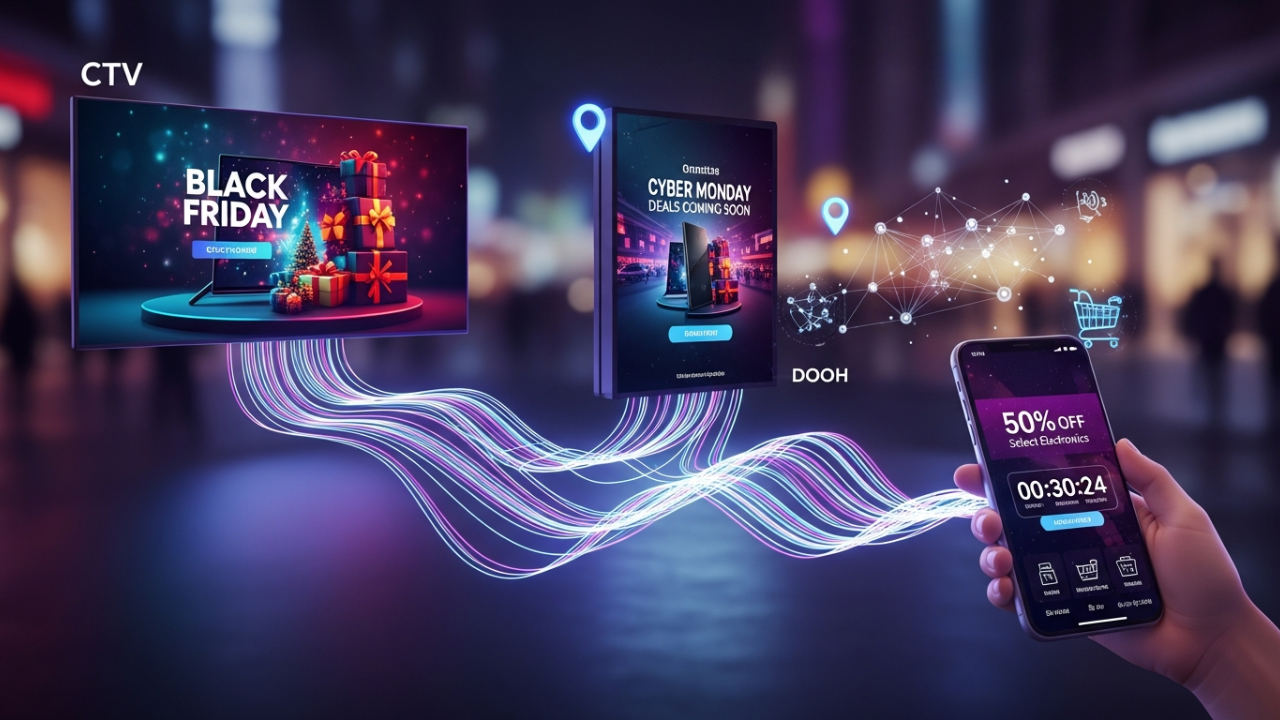Blog
Announcements, analysis and opinions on industry trends around the mobile programmatic world.

Subscribe now, and receive the latest programmatic content directly on your inbox!
Thank you for subscribing to our newsletter
There’s no denying consumer habits have changed drastically post-pandemic, resulting in an intertwining between the online and offline worlds. This is a time when CTV and DOOH advertising could really help brands up their marketing game.
On one hand, as reported by Nielsen, the time users spend on their Connected TV (CTV) devices increased by 81% year-over-year from 2019. People have a wider variety of TV offerings to choose from. For example, Advertising-based video-on-demand (AVOD) platforms like Roku, Peacock, and Pluto TV, are experiencing a major boom, with revenues expected to reach $70 billion in 2027.
While on the other hand, specifically after covid, people are looking for the outdoors more than ever. Tourism is expected to grow by 30% in 2023, and may push or even exceed pre-pandemic levels. Many have dubbed this phenomenon “Covid-19 revenge travel” — in an effort to make up for precious time lost consumers are expressing their desires and plan to be outdoors more than they previously had.
This year, advertisers should consider the fact that their audience may have a desire to both participate in outdoor activities and consume online content on various devices while developing their engagement campaigns.
In this blog, we explore the advantages CTV and DOOH advertising offer in terms of viewership, inventory, measurability, and supported ad formats. These two channels will enable advertisers to reach consumers as they move throughout the day, in and outside of their homes, with consistent creativity and messaging to reinforce their brand impact.
CTV and DOOH advertising: Viewership Growth
Connected TV adoption has increased significantly globally. In 2022, a whopping 92 per cent of U.S. households were accessible by CTV advertising, while the number of CTV users amounted to more than 110 million among Gen Z and Millennials.
A recent report by Amagi shows that in Europe, France and Italy have a 120% and 111% growth respectively in terms of hours of CTV viewing in Q3 2022 as compared to Q3 2021.
Countries like Indonesia are leading the migration towards digital in APAC with the implementation of a complete analogue switch-off in 2022. Moreover, according to our recent study, 84% of households in India have more than 1 person watching CTV and 64% of respondents claimed to prefer watching CTV with their families.
On the other side of the globe, we have also discovered that 91% of TV viewers in the LATAM region consume streaming TV every week.
As for Digital-Out-Of-Home Advertising, according to the latest Nielsen studies, DOOH increases engagement, and consumer awareness and prompts consumer action. Their studies report that 52% noticed digital billboards that gave directions to a store, business, or restaurant. 57% of them immediately visited the business after viewing the ad. 93% of those visiting the business made a purchase.
To top that, DOOH greatly enhances the OOH experience for viewers. It offers more interactivity with touch screens and dynamic content to improve the relevance of the ads (i.e. through weather-based targeting, location-based targeting, creative optimization, etc.). According to the same Nielsen study, 52% of viewers with smartphones have engaged in actions on their mobile devices after seeing a digital billboard in the past year.
CTV and DOOH advertising: Optimized Inventory
The growth of AVOD and SVOD platforms and the increased availability of premium inventory they provide will enhance programmatic advertising on CTV. This is due to the fact that streaming services gather more specific information about their viewers, which programmatic marketers can utilize to more accurately align their target audience with platforms such as mediasmart.
As for opportunities in DOOH advertising, according to the latest report from VIOOH in partnership with MTM, advertisers and agencies in the US are expected to increase their spending on both digital and programmatic OOH, with the latter seeing an uptick in usage in 2023. Around 46% of the surveyed agency executives are considering investments in programmatic OOH in the next 12 months. The interest in DOOH is palpable.
Furthermore, if you are running an out-of-home campaign, you can retarget the users having seen your billboards, point-of-sale displays, or ads on street furniture (bus shelters, kiosks, telephone booths, etc.) on their mobile or CTV devices. Through geofencing and proximity marketing, advertisers can create audiences based on the user’s location patterns to target them through multiple mediums. This enables them to increase interaction, convey more pertinent information to consumers in larger, more enticing formats, and assess the campaign's effectiveness based on sales— all at once!
CTV and DOOH advertising: Increased Measurability
CTV advertising opens up a whole world of campaign success measurement possibilities, in comparison to traditional TV where you couldn't know with certainty how many times your ad had been seen. Nevertheless, the complexity of the digital side of the ecosystem plays a big part in the lack of standards for the performance measurement of CTV campaigns. Some of the steps in that regard have been taken by MMPs now supporting cross-screen targeting making CTV to be more measurable, similar to other digital channels.
Also, with technologies like mediasmart’s household sync, you can add a fundamental layer of interaction with the user on their mobile devices. Once a user sees your ad on their CTV, you can follow up with an ad on their mobile device(s) with a Call-To-Action, getting a lead through a landing page, leading to your website for more information, or directly making a purchase.
Similarly, DOOH advertising when paired with the right technology partner allows for increased measurability. Not only is it possible for you to target mobile users around DOOH screens, but also to collect the Mobile device IDs in the vicinity of those screens within a timeframe of the impression being served, but you can also add Drive-to-store or footfall measurement to DOOH campaigns through mediasmart. Through this, you can identify users who have been seen around your DOOH ad and have been seen later around your store. This will help you compare conversion rates for users exposed to the campaign versus those that were not.
All in all, cohesive omnichannel campaigns where results can be measured are a new reality that will come with force in 2023. Mediasmart’s synchronization capabilities both our DOOH Audience Sync tool and Household Sync tool for CTV will turn users' attention around and improve your campaign's impact tenfold.
CTV and DOOH advertising: Engaging Ad formats
Running CTV as well as DOOH campaigns can go further than simply adding a creative and be done. Say the weather is unpleasant, all the more reason for someone to want to go on a trip to the Beach that is being advertised on their TV; don’t you think? Through mediasmart, it is easy to automatically optimize advertising content according to weather conditions, and a whole list of variables; ranging from a day to location, time of the day, the language of the device, etc. All of it partnered up with automated performance measurement, thus building dynamic creatives to maximize engagement or conversion rates.
Measuring engagement could be tricky in such different mediums as CTV and DOOH, just as mentioned in the previous section. Some advertisers have jumped into the opportunity of giving QR codes for final users to scan. This might be more convenient in a DOOH ad, but is certainly a hassle on CTV. While improving the interaction rate on new screens, is definitely a trend to look out for in 2023, we think there are other ways forward than QR codes. In mediasmart, we are convinced there is a smarter way to make campaigns more likely to be interacted with - not only through our Maximize user awareness patent-pending tool- but by using engaging creatives to make it easier for users to click on the ads. Both our DOOH Audience Sync and CTV Household Sync solutions will allow retargeting users on their mobile devices. This will help maximize the impact of a brand by seamlessly reaching consumers across multiple screens. By closing the gap and providing a consistent experience, marketers can drive engagement and strengthen their message.
With such dynamic creative options and a bunch of different channels to be targeted, one of the pitfalls every advertiser needs to look out for in 2023 is message consistency. It is key to maintain the consistency of messaging across the board. Advertisers can decide if they want to launch the same message or innovate and generate a campaign with different stages on different screens, as long as the big picture, the communication strategy remains strong. For that matter, being able to manage every campaign stage and creative iteration from the same place is key; which is something easily done with our technology.
In conclusion, the timing and technology are ripe for advertisers to take advantage of CTV and DOOH advertising. Keeping branding strategies at the core, CTV presents advertisers with new opportunities to take advantage of a super mix of storytelling, cross-media insights, and analytics. And, DOOH helps combine both creativity and addressability to target the right areas with personalized messages, at the right time. With the viewership, inventory, programmatic capabilities, and measurability these mediums offer, marketers and brands have the best possible opportunity in 2023 to marry the two with Mobile to build powerful and effective campaigns.
Topics: market trends, connected tv, programmatic, AdTech trends, ctv advertising, 2023, dooh advertising


